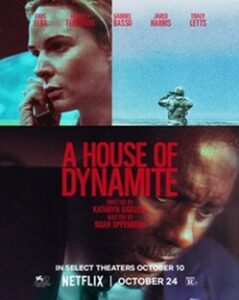Another Vital Wake-Up Call: ‘A House of Dynamite’ and the Nuclear Threat
by John Whitehead
The threat from nuclear weapons seems to be receiving more attention these days. Over the past few years, members of the media and entertainment industry have been raising the alarm in various ways about the ongoing danger to humanity from current stockpiles of thousands of nuclear weapons.
An addition to this growing list of warnings to the public is the new movie A House of Dynamite, which was released onto Netflix on October 24, after a brief release in theaters. A House of Dynamite dramatizes the kind of chain of events, and twisted logic, that could lead to nuclear war today.
How Nuclear War Might Occur
The movie revolves around the (quite realistic) premise that the US government receives early warning that what appears to be a nuclear missile has been launched and is heading toward the United States. As the missile’s brief flight toward its target unfolds, American civilian and military authorities attempt to answer crucial questions: Is this a genuine nuclear attack? If so, is this single incoming missile soon to be followed by many more? Who launched such an attack? Above all, how should the president decide to respond?
This story is told from the perspectives of a variety of people, including military personnel at an Air Force base charged with tracking the missile; civilian officials at the White House and FEMA; and top-level policymakers such as a deputy national security advisor and the president. The movie is structured in three acts, each of which re-plays the events surrounding the incoming missile from the viewpoints of a different set of characters. Every time the sequence of events is repeated, we get more information on the crisis.
The Movie’s Strengths
Purely as a movie, A House of Dynamite works well as a very suspenseful thriller. Beyond that, the movie effectively highlights some of the specific dangers of a world with multiple nuclear-armed nations.
The central problem the movie examines is the very real risk of nuclear war being triggered by accident. The premise is clearly inspired by the many real-life nuclear close calls caused by technical errors, such as the 1983 Stanislav Petrov incident, which one character explicitly mentions. A warning of an incoming attack may or may not prove to be accurate—but if a nation responds to such a warning with a retaliatory nuclear attack, the result will be nuclear war even if the initial warning was incorrect.
Further, the movie demonstrates the extremely limited time frame in which decisions about how to react to a possible impending nuclear attack must be made. If one or more nuclear missiles are launched at the United States or any other nation, top policymakers will have less than an hour—possibly only a few minutes—to decide how to respond.
This time pressure can create a strong temptation to “launch on warning”: that is, to launch a retaliatory nuclear attack as soon as possible, before the incoming missiles damage the military’s ability to retaliate. Such pressures don’t encourage careful reflection or restraint.
Another issue A House of Dynamite raises is a version of what is sometimes called “the security dilemma.” The dilemma is that actions a nation takes to deter or defend itself from an aggressor can easily be interpreted by other nations as aggressive moves directed at them. Those other nations then respond with defensive measures of their own that are interpreted as aggressive moves, and the cycle continues, with accompanying rises in the risk of open war.
We see this happen in the movie, as the warnings of an incoming missile are accompanied by heightened military readiness by nations such as Russia and China. Does this mean one of these nations is behind the attack? Or are they simply responding to the heightened military readiness in the United States prompted by the warnings? The answer is unclear, and characters argue about how to interpret such ambiguous information.
Other issues touched on include the limited value of anti-ballistic missile systems and the challenges of ensuring clear communication in a crisis. The latter problem provides a running bit of gallows humor in the movie, as characters repeatedly struggle, through cellphones or other patchy communications technology, to convey information and advice clearly. Along with communications breakdowns, the movie shows how protocols and discipline start to fracture in a crisis, as panic and a sense of futility begin to take over.
One subtle but potent theme in A House of Dynamite is how military authorities can overwhelm civilian ones in this type of situation. Military personnel are trained to think in terms of military responses to problems and to rehearse such responses constantly. Faced with a potentially disastrous nuclear crisis, military officers’ recommendations might prevail over more restrained, diplomatic responses simply because the military has seemingly the most definite and practiced plan.
For me, the most quietly chilling scene in A House of Dynamite is when the general in command of US nuclear forces makes the case to the president for a radical option: the United States should launch nuclear strikes against all its potential enemies (Russia, China, North Korea, etc.) to ensure no further missile attacks can be made against the United States. The general is calm, composed, and speaks with an assurance lacking from the harried, uncertain civilians around him. Viewed objectively, the general’s advice is crazy and profoundly immoral—yet in the heat of the moment, it could come across as persuasive.
The Movie’s Limitations
A House of Dynamite does an excellent job of illustrating the nuclear threat by showing how easily one event can turn into a potential global disaster. As a call to action against nuclear weapons, though, the movie does have some limitations.
The first limitation is not the filmmakers’ fault but simply the result of the current media landscape:
When the nuclear war drama The Day After (which seems to be one inspiration for A House of Dynamite) aired on ABC on November 20, 1983, more than 100 million people—most of the American adult population at the time—watched it. The audience was so large because at the time only three major TV networks existed in the United States and programs were available for free viewing.
Today, A House of Dynamite airs on a paid streaming service that must compete for viewer attention with other streaming services, network and cable TV, and innumerable types of online content. A single movie cannot easily grab wide public attention the way it used to.
The second limitation is that while A House of Dynamite vividly depicts the severity of the nuclear threat, it provides little sense of what anyone can do in response to the threat. Granted, that is not the movie’s goal, so it may be unfair to judge it by that standard. Nevertheless, the intense power of the movie’s message will be wasted if viewers don’t translate that message into action.
Taking Action
A House of Dynamite is a valuable contribution to raising awareness about the danger from nuclear weapons. The movie is only one part of this effort, though: moving the public to act requires urgent repetition of the message that, at any given moment, humanity could perish in a nuclear war and that we need to take positive steps to check the nuclear danger.
People should watch A House of Dynamite, encourage other people to watch it, and discuss it afterwards. They should not stop there, though, but should continue to learn about the nuclear threat from other sources. Valuable introductory books to read on the topic include Jonathan Schell’s classic works The Fate of the Earth and The Abolition, William Perry and Tom Z. Collina’s The Button, and Annie Jacobsen’s Nuclear War: A Scenario.
Artists, journalists, and activists should similarly continue to create works of fiction and non-fiction, in a variety of media, to send clear messages about the necessity of acting to prevent nuclear war.
People from all walks of life should support initiatives to reduce the nuclear danger. Two worthwhile initiatives I have written about before are the Back from the Brink campaign’s five policy responses to the nuclear threat and the effort to renew arms control agreements between the United States and Russia.
Both initiatives have produced legislation currently before the US Congress: H.Res 317/S.Res.323 advocate for adopting the Back from the Brink policies and H.Res 100/S.Res 61 advocate for a new arms control treaty. US citizens can contact their representatives and senators, as well as the Trump administration (by email or phone 202-456-1111) to urge them to support this legislation. Back from the Brink and the Arms Control Association offer resources for lobbying elected officials on these pieces of legislation.
By raising awareness and advocating for policy changes, we can build a movement to protect humanity from nuclear weapons.
Another way to join the movement against nuclear weapons is to attend the Consistent Life Network’s quarterly peace vigil outside the White House in Washington, DC. The next vigil will be on November 2.
==============================
For more of our posts on similar topics, see:
Nukes and the Pro-Life Christian: A Conservative Takes a Second Look at the Morality of Nuclear Weapons
“An Inferno That Even the Mind of Dante Could Not Envision”: Martin Luther King on Nuclear Weapons
Persuading People to Act against the Nuclear Threat: Some Findings and Recommendations
Nuclear Disarmament as a Social Justice Issue
See a more extensive list under “Nuclear Weapons” on our list of all blog posts.


Leave a Reply